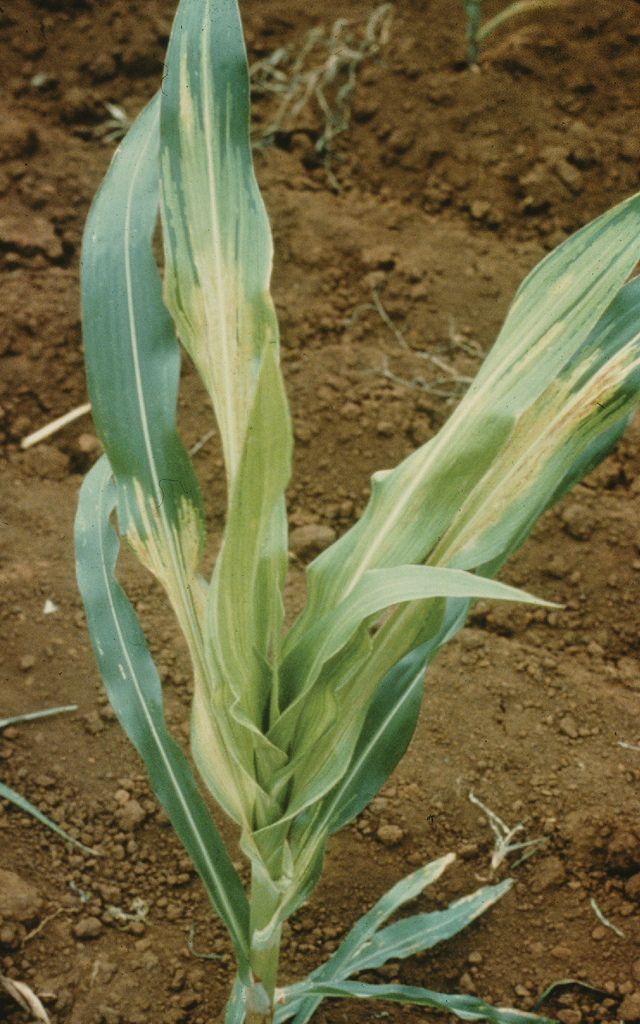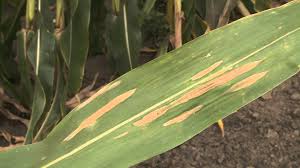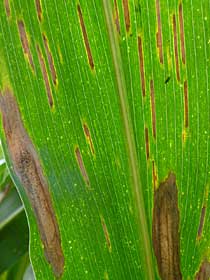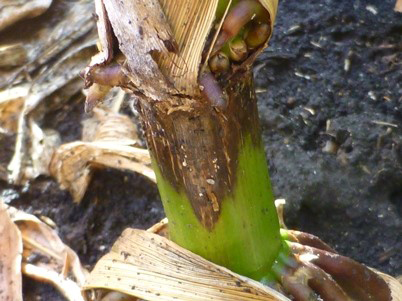DOWNY MILDEW
It is most common diseases of maize. In Nepal 2 types are found brown stripe downy mildew and philipino downy mildew which are caused by Scleropthora rassyi var. zeae and Peronosclerospora philipinensis respectively. In brown stripe type, symptoms appear on leaf as yellowish lesion in between veins which later on change into brown color also in morning downy fungal growth appears around lesion. In philipino type, there is crazy top symptoms i.e. dwarf plant with many leaves originating from limited region also leaves become small sized with chlorotic sometimes whitish appearance.
MANAGEMENT
- Seed treatment with mercurial or systematic fungicide Bavistin@ 2gm/kg seed. Spraying can also be done but it is not practical in farmers level.
- Use of resistant variety Rampur composite, Indian variety Ganga safeda is also resistant.
BLIGHT
Southern Leaf Blight
This is caused by two pathogens namely Drechslera maydis, Bipolaris maydis. Generally, it appears during summer season. Smaller boat shaped lesion developed in between veins which are initially chlorotic later change into brownish and finally becomes straw colored. The lesions never becomes blackish color.
Northern Leaf Blight
This is caused by multiple pathogens namely Helminthosporium turcicum, Drechslera turcicum, Bipolaris turcicum. It appears in winter season. Larger boat shaped lesion developed across the vein which are initially tan later change into brownish and finally becomes blackish.
Cercospora Leaf Blight
This is caused by Cercospora zeae-maydis and it is prevalent in hilly regions. It begins from lower leaves and  moves upward. Symptoms can be seen as rectangular tan spot in between veins which later changes into brown and finally becomes straw color. In severe case, whole plant may be killed.
moves upward. Symptoms can be seen as rectangular tan spot in between veins which later changes into brown and finally becomes straw color. In severe case, whole plant may be killed.
MANAGEMENT
- See treatment with fungicide like Captan, Thiodan.
- Foliar spray with Iprodine@ 0.1% (2-3 sprays at 15 days interval)
- Resistant variety like Rampur composite, Ganga Safeda can be used
- Removal of collateral host
STALK ROT
This is fungal and bacterial disease. The causative agent are fungus like Pythium debarianum, Fusarium moniliforme, Cephalosporium maydis, Diplodia maydis and bacteria like Erwinia carotovora,  pseudomonas spp. In fungal rot, 1st and 2nd internode near the ground get attacked. Symptoms may appear as shrinking of attacked internodes, discoloration of pith (yellowish, reddish or brownish) and if we cut we can find dirty white fungal mycelial growth. In bacterial attack, nodes get discolored, bacterial ooze comes out from node with foul smell. In both of the cases plant get topple down even under light air blow.
pseudomonas spp. In fungal rot, 1st and 2nd internode near the ground get attacked. Symptoms may appear as shrinking of attacked internodes, discoloration of pith (yellowish, reddish or brownish) and if we cut we can find dirty white fungal mycelial growth. In bacterial attack, nodes get discolored, bacterial ooze comes out from node with foul smell. In both of the cases plant get topple down even under light air blow.
MANAGEMENT
- Soil treatment or soil solarization
- Use of bio control agent fungus like Trichodema harzianum, Trichoderma viride, Gliocladium virens and bacteria like Pseudomonas fluorescence.
- Development and use of resistant variety
